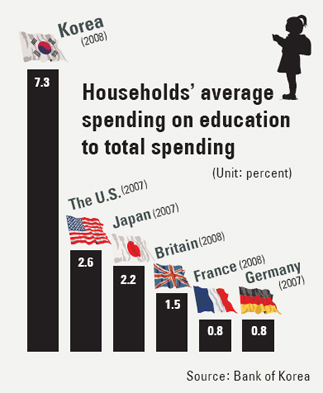Education spending in Korea pinching economy

But now such unlimited spending for after-school classes, school textbooks, tuition for private cram schools, tutoring and prestigious foreign schools may be dragging down a much-needed economic revival here, Korea’s central bank says.
According to a report yesterday from the Bank of Korea, Koreans spent 7.4 percent of their household budgets on education within the country during the first half of this year and 7.3 percent during 2008.
This represents a sharp rise from the 5.4 percent they spent only nine years ago.
The 2008 figures are far higher than tallies from other countries.
For instance, the British spent 1.4 percent of their family income on education in 2008 while the French set aside some 0.8 percent.
In 2007, the figure in the United States came in at 2.6 percent.
Although it has a well-known reputation for fierce educational competition, intense pressure to get into good colleges and a thriving private education market for its teenage students, Japan’s spending in 2007 - at 2.2 percent of a family budget - was less than a third of what Koreans are currently dishing out.
And it doesn’t stop there.
When spending within the nation is combined with what Korean parents are spending to send their children to study at overseas schools and colleges, the figure surges to 8.2 percent in the first half of 2009.
In 2008, the combined figure was 5.8 percent.
In Korea, one’s prospects in life, including jobs, marriages and overall social status, have long been determined by whether or not they have a college diploma, and whether they are admitted to one of top prestigious colleges.
That means local fathers have long been willing to take out bank loans, or work additional hours, while mothers get part-time odd jobs to finance the snowballing cost for their children’s private education and ace the college entrance exams.
As of 2007, about 61 percent of Koreans enter colleges, higher than the 56 percent average that enter colleges in other countries of the Organization for Economic Cooperation and Development. The number was 34 percent in Germany, 46 percent in Japan and 55 percent in Britain.
Medical spending is also taking a toll in Korea.
Its total of household spending has expanded to 6.4 percent during the first half of this year, up from 3.9 percent in 2000. That figure is far higher than 1.6 percent of income set aside by the British, the 3.6 percent by the French, the 4.1 percent by the Japanese and the 4.6 percent by the Germans.
These two spending categories are major hurdles that slow much-needed domestic spending, the central bank said.
It said that the growing amount of overseas bank remittances for children studying abroad helps little to revitalize the local economy.
“The spillover economic impacts that education and medical services have on other industries amount to only 80 percent of the overall impacts of all industry types,” said Kim Myung-ki, the Bank of Korea’s economic statistical office director.
“We need policies to divert some of the consumers’ spending on education and medical services to other areas,” he added.
By Jung Ha-won [hawon@joongang.co.kr]










with the Korea JoongAng Daily
To write comments, please log in to one of the accounts.
Standards Board Policy (0/250자)